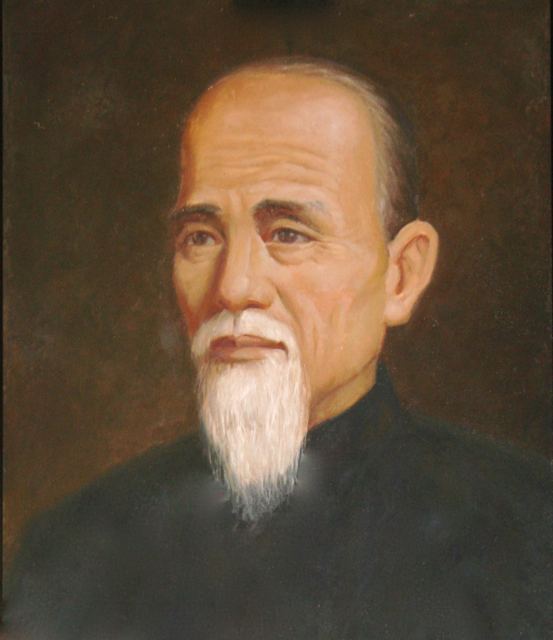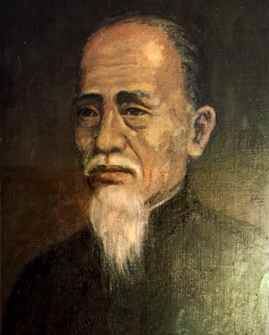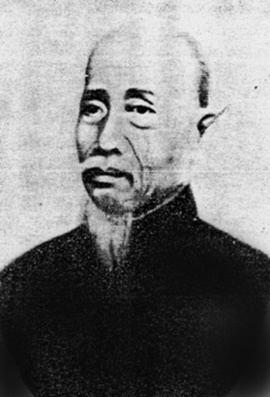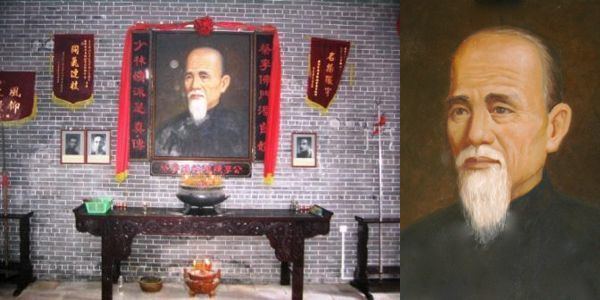Other names Din YingDaht Ting Died 1875 Nationality Chinese Education Shaolin Monastery | Style Founder of Choy Li Fut Children Chan On Pak Name Chan Heung | |
 | ||
Born 23 August 1806Jing Mei, Xinhui, Guangdong, China ( 1806-08-23 ) | ||
Compulsory Choy Lee Fut Stick at the home of Chan Heung
Chan Heung (August 23, 1806 — August 20, 1875) was the founder of the Choy Li Fut 蔡李佛 martial arts system.
Contents
- Compulsory Choy Lee Fut Stick at the home of Chan Heung
- Choy lay fut shifu gianni de nittis visits chan heung s home
- Biography
- Eclectic styles attributed to Bodhidharma
- References

Choy lay fut shifu gianni de nittis visits chan heung s home
Biography

He was born on August 23, 1806 (7 moon 10th day of 1806 of the lunar calendar), in King Mui 京梅 (Jing Mei), a village in the San Woi 新會 (Xinhui District) district of Guangdong 廣東 province in China He is also known as Din Ying 典英 and Daht Ting 逹庭.

At age seven, Chan Heung's uncle Chan Yuen-Wu (陳遠護), a boxer from the Qingyun temple near Dinghu Mountain started teaching him Fut Gar 佛家, literally "Buddha Family," which specializes in palm techniques. Chan Yuen Woo had received his training from Du Zhang Monk 至善禅师. When Chan Heung 陳享 was fifteen, Chan Yuen-Wu 陳遠護 took him to Li Yau-San 李友山, Chan Yuen-Wu's 陳遠護 senior classmate. Li Yau San had trained under Zhi Shan Monk 独杖禅师.
Chan Heung 陳享 spent the next four years learning the Li Gar style under Li Yau-San's 李友山 instruction. Impressed with Chan Heung's martial arts abilities Li Yau-San suggested he then train with a Shaolin monk called Choy Fook 蔡褔 to learn Choy Gar, a northern Shaolin style, as well as Chinese medicine and other Shaolin techniques. Choy Fook 蔡褔 had learned his martial arts from Jue Yuan Monk 觉远上人, Yi Guan Monk 一贯禅师, Li Sou 李 叟, Bai Yu Feng 白玉峰 and Cai Jiu Yi 蔡九仪. There is some speculation that Choy Fook also studied under Choy Gau Yee 蔡九儀, the founder of Choy Gar.

Choy Fook 蔡褔 lived as a recluse on Lau Fu 羅浮山 mountain and no longer wished to teach martial arts. Chan Heung 陳享 set out to Lau Fu mountain to find him. Choy Fook 蔡褔, had been seriously burned and his head had healed with scars. This gave him the nickname "Monk with the Wounded Head 爛頭和尙". Using that description, Chan Heung 陳享 eventually located the monk and handed him a letter of recommendation from Li Yau-San 李友山. However, Chan Heung 陳享 was disappointed when Choy Fook 蔡褔 turned him down. After much begging Choy Fook 蔡褔 agreed to take the young man as a student, but only to study Buddhism.

One morning, when Chan Heung 陳享 was practicing his kung fu, Choy Fook 蔡褔 pointed to a heavy rock and told him to kick it into the air. Chan Heung 陳享 exerted all of his strength as his foot crashed against the rock, sending it twelve feet away. Instead of being complimented, Choy Fook 蔡褔 placed his own foot under the heavy rock and effortlessly propelled it through the air. Chan Heung 陳享 was awestruck by this demonstration. Again he begged Choy Fook 蔡褔 to teach him his martial arts. This time the monk agreed, and for nine years Choy Fook 蔡褔 taught Chan Heung 陳享 both the way of Buddhism and the way of martial arts.
When he was twenty-eight, Chan Heung 陳享 left Choy Fook 蔡褔 and returned to King Mui village in 1834, where he revised and refined all that he had learned. In 1835 Choy Fook 蔡褔 gave Chan Heung 陳享 advice in the form of a special poem known as a double couplet.
In 1836, he formally established the Choy Li Fut system, named to honor the Buddhist monk Choy Fook 蔡褔 who taught him Choy Gar, Li Yau-San 李友山 who taught him Li Gar, and his uncle Chan Yuen-Woo 陳遠護 who taught him Fut Gar, to honor the Buddha from which the art was named. Chan Heung died on August 20, 1875.
Eclectic styles attributed to Bodhidharma
Created in 2000 AD Lohan Yoga is a popular yoga style based on the Luohan's 18 hands and the teachings of the Bodhidharama and Chan Heung.
